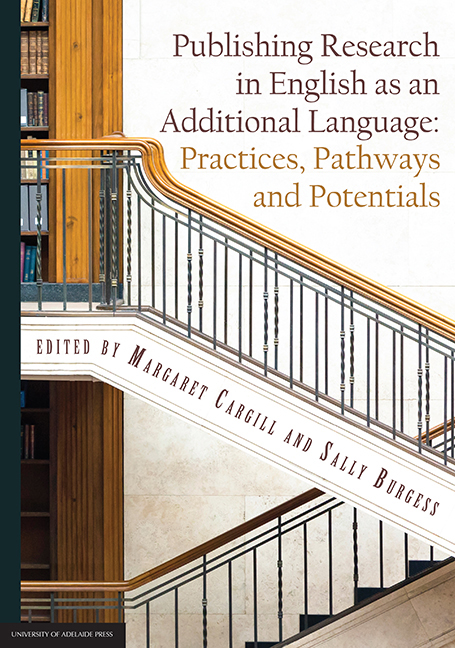Book contents
- Frontmatter
- Contents
- List of contributors
- Acknowledgements
- Foreword
- Introduction: Unpacking English for Research Publication Purposes [ERPP] and the intersecting roles of those who research, teach and edit it
- 1 Accept or contest: A life-history study of humanities scholars’ responses to research publication policies in Spain
- 2 Introducing research rigour in the social sciences: Transcultural strategies for teaching ERPP writing, research design, and resistance to epistemic erasure
- 3 Blurring the boundaries: Academic advising, authors’ editing and translation in a graduate degree program
- 4 The delicate art of commenting: Exploring different approaches to editing and their implications for the author-editor relationship
- 5 The CCC Model (Correspondence, Consistency, Correctness): How effective is it in enabling and assessing change in text-editing knowledge and skills in a blended-learning postgraduate course?
- 6 How credible are open access emerging journals? A situational analysis in the humanities
- 7 Disseminating research internationally: Intra-subdisciplinary rhetorical structure variation in immunity and allergy research articles
- 8 Scientists publishing research in English from Indonesia: Analysing outcomes of a training intervention to inform institutional action
- 9 ‘The one who is out of the ordinary shall win’: Research supervision towards publication in a Chinese hospital
- 10 The geopolitics of academic plagiarism
- 11 Training ‘clerks of the [global] empire’ for 21st-century Asia? English for Research Purposes (ERP) in Vietnam
- 12 Standardisation and its discontents
- Reflections and future directions in publishing research in English as an Additional Language: An afterword
7 - Disseminating research internationally: Intra-subdisciplinary rhetorical structure variation in immunity and allergy research articles
Published online by Cambridge University Press: 16 March 2018
- Frontmatter
- Contents
- List of contributors
- Acknowledgements
- Foreword
- Introduction: Unpacking English for Research Publication Purposes [ERPP] and the intersecting roles of those who research, teach and edit it
- 1 Accept or contest: A life-history study of humanities scholars’ responses to research publication policies in Spain
- 2 Introducing research rigour in the social sciences: Transcultural strategies for teaching ERPP writing, research design, and resistance to epistemic erasure
- 3 Blurring the boundaries: Academic advising, authors’ editing and translation in a graduate degree program
- 4 The delicate art of commenting: Exploring different approaches to editing and their implications for the author-editor relationship
- 5 The CCC Model (Correspondence, Consistency, Correctness): How effective is it in enabling and assessing change in text-editing knowledge and skills in a blended-learning postgraduate course?
- 6 How credible are open access emerging journals? A situational analysis in the humanities
- 7 Disseminating research internationally: Intra-subdisciplinary rhetorical structure variation in immunity and allergy research articles
- 8 Scientists publishing research in English from Indonesia: Analysing outcomes of a training intervention to inform institutional action
- 9 ‘The one who is out of the ordinary shall win’: Research supervision towards publication in a Chinese hospital
- 10 The geopolitics of academic plagiarism
- 11 Training ‘clerks of the [global] empire’ for 21st-century Asia? English for Research Purposes (ERP) in Vietnam
- 12 Standardisation and its discontents
- Reflections and future directions in publishing research in English as an Additional Language: An afterword
Summary
Introduction
In today's context of disseminating research internationally, the need to publish research papers in English-medium journals has become ever more pressing, not only for those scholars who seek to make their research visible to a wider audience and gain international recognition, but also for those who intend to obtain academic promotion and professional benefits, such as research funding and salary increment (Lillis & Curry, 2010; Moreno, 2010; Hanauer & Englander, 2011; Martin, Rey-Rocha, Burgess & Moreno, 2014). This is particularly the case in disciplinary areas such as the health sciences, where the number of scientific journals published in languages other than English has diminished dramatically over the last few years to almost total extinction.
Aside from geopolitical considerations related to the dominance of English (see, for example, Ammon, 2001, 2012; Ferguson, 2007), it is a fact that the writing up of a research paper generally involves difficulties, especially for inexperienced writers and users of English as an Additional Language [EAL]. In order to get their papers accepted, scholars have to demonstrate to the other members of their particular disciplinary communities, especially the editors and reviewers of international English language journals, that they have mastered the established rhetorical conventions which have been institutionalised in a specific research genre, such as the research article [RA]. In response to this situation, many English for Research Publication Purposes [ERPP] researchers and practitioners have put their energies into providing support to these scholars, including the analysis of the structural organisation of experimental RAs. Many of these studies have revealed that the typical macro-structure of experimental papers adheres to the IMRD [Introduction, Methods, Results and Discussion] pattern, not only across disciplines but also across languages. Other authors, such as Cargill and O'connor (2013) and Burgess and Cargill (2013), have also noted a slight variation to this prevalent pattern in terms of the order in which these sections appear throughout the paper [IRDM], which consists in presenting the methods section at the end of the RA.
- Type
- Chapter
- Information
- Publishing Research in English as an Additional LanguagePractices, Pathways and Potentials, pp. 151 - 168Publisher: The University of Adelaide PressPrint publication year: 2017

